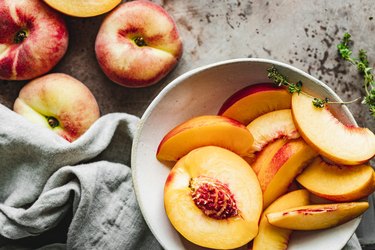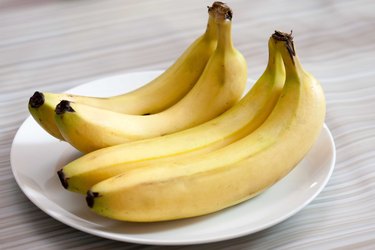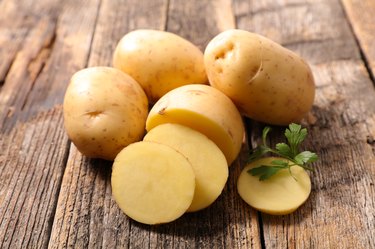
Peach season runs from May to September, which doesn't give you much time to enjoy this sweet, juicy fruit.
Fortunately, there's a fix: Freezing or canning your ripe peaches in the summer will allow you to enjoy them throughout the year and brighten the dull, dark days of winter.
Video of the Day
Video of the Day
The best way to preserve fresh peaches involves making sure the bright golden fruit doesn't turn a dull brown, which usually occurs after slicing them.
Why Peaches Turn Brown
One of your main priorities when freezing or canning peaches will be to prevent the fruit from turning brown. First, it might be helpful to understand why peaches turn brown.
When you slice a fresh peach, enzymes called polyphenol oxidases (PPOs) are activated by the exposure to oxygen, according to the University of California, Davis. Through a rather complex process, these enzymes create highly reactive brown pigments called quinones, which are quickly oxidized, causing your once-bright fruit to turn an unappetizing brown.
This browning process is one of the reasons peaches — along with bananas, avocados and apples — have such a short shelf life when cut. However, note that this type of browning is not harmful to eat.
Tip
Peaches turning brown on trees before they’re picked isn’t caused by the same chemical reaction as the brown sliced peaches. Peaches that brown on the tree are infected with brown rot fungus. Once infected, the peaches quickly turn brown and rot, making them inedible, according to Ohio State University Extension.
How to Keep Peaches From Turning Brown
In order to keep peaches from browning, you'll want to use some kind of anti-darkening treatment, per Colorado State University Extension. There are a few different solutions you can use, depending on your preferences.
Tip
Stop sliced peaches from turning brown by adding an acid — such as lemon juice, ascorbic acid or a commercial anti-darkening agent made for fruit — immediately after cutting them.
Vitamin C
Ascorbic acid is vitamin C that you can find at pharmacies and stores where canning supplies are sold. It helps preserve fruits' color and flavor (and it'll also add some vitamin C).
Ascorbic acid is available in powdered, crystalline and tablet form. You'll want to dissolve the acid in cold water before using it to treat your peaches. Ascorbic acid is said to be the most effective agent for preventing browning.
There are several ways to use ascorbic acid to freeze peaches — here are a few that don't require any added sugar or syrup:
1. Unsweetened Packs: Sprinkle dissolved ascorbic acid over fruit, and mix thoroughly just before packing. If the fruit is packed in water or juice, dissolve the ascorbic acid in the water or juice. This can be a great option for when you're using fresh (not frozen) peaches in a recipe and want to maintain their golden hue.
2. Fruit Juices: Add ascorbic acid directly to the juice. Stir only enough to dissolve ascorbic acid.
3. Ascorbic Acid Mixtures: You may be able to find commercial anti-darkening products, which tend to include ascorbic acid mixed with sugar. Follow the manufacturer's instructions for freezing peaches.
4. Crushed Fruits and Fruit Purees: Add dissolved ascorbic acid to fruit preparation and mix.
Citric Acid or Lemon Juice
You can also use citric acid or lemon juice to treat peaches prior to freezing, though neither solution will be effective as ascorbic acid, per Colorado State University Extension.
- Mix 3 tablespoons of lemon juice in each quart of cold water. (You can also use 1/4 teaspoon crystalline citric acid instead of lemon juice.)
- Dip the prepared fruit in the solution and let sit for 1 to 2 minutes.
- Drain and pack with water, sugar, syrup or fruit juice. (More info on making syrup below.)
How to Freeze Peaches Without Them Turning Brown
Peaches are available at their freshest for only a few months, so if you want to enjoy them beyond summer, you can freeze them.
For ideal freezing conditions, select peaches that are firm and ripe. Avoid choosing peaches that are badly bruised and very soft — a sign that the peach has likely gone bad. Start by washing the peaches, then pit them, cutting them in halves, quarters or slices.
If you choose to peel peaches, you can do so faster by using boiling water, per the Clemson Cooperative Extension. Peeling is completely optional — in fact, the peach peel contains fiber and other nutrients so you might want to keep it on.
- Dip a few peaches at a time into boiling water for 30 to 60 seconds. Transfer the peaches immediately into ice water.
- Now, the skins should slip off easily. Cut the peaches in half and remove the pit. Slice them into the size you like and treat them to prevent browning with a vitamin C (ascorbic acid) and water solution.
- Put the sliced fruit into a water and vitamin C solution prepared at a ratio of three crushed 500-milligram vitamin C tablets to a 1/2 gallon of water.
- When all the peaches have been treated, drain the water and sprinkle on 1/2 cup of sugar for each quart of peaches.
- Stir gently and let the fruit stand for 15 minutes. The peaches will begin to make their own juice.
- Pack the peaches into freezer bags to within 3 to 4 inches of headspace at the top. Squeeze out the air, seal, label and freeze. You can also use rigid plastic containers. Leave about an inch of headspace before freezing.
- When thawed, the peaches will have a softer texture than when they were fresh, but they will still taste great.
Tip
If your peaches are not quite ripe enough, place them in a paper bag, pierce the bag in several places and set it aside at room temperature for a couple of days. Add an apple to the bag to speed up the ripening process.
Freezing Puréed or Crushed Peaches
Follow these instructions, from the National Center for Home Food Preservation, to safely freeze puréed peaches:
- Coarsely crush peeled and pitted peaches.
- For purée, press through a sieve or purée in a blender or food processor. (Heating pitted peaches for 4 minutes in just enough water to prevent scorching makes them easier to purée.)
- Add 1/8 teaspoon of ascorbic acid to each quart of fruit to maintain the integrity of the peaches.
- Pack into containers, leaving 1 inch of headspace for every quart.
- Seal the container and freeze.
How to Make Sugar Syrup for Freezing Peaches
You can follow the steps above, or you can freeze peaches in a syrup mixture, per Colorado State University Extension. In this context, "syrup" is a mixture of sugar and water. Freezing peaches in sugar is not necessary, but you'll still want to use some kind of anti-darkening solution (like the options above).
You can also freeze whole peaches and avoid the browning altogether.
To make the syrup, dissolve sugar in cold or hot water. If you're using hot water, cool the syrup before using it. You can make the syrup a day in advance and keep it covered in the refrigerator. You can replace up to 1/4 of the sugar with corn syrup or honey.
While you may not want the added calories of sugar mixed with your fruit, it's possible to adjust the amount of sugar you use. See the different proportions possible in the sugar syrup chart below.
Sugar Syrup Recipes
Type of syrup (% syrup) | Sugar (cups) | Water (cups) | Syrup Yield (cups) | Calories per 2/3 cup |
|---|---|---|---|---|
10 | 1/2 | 4 | 4 1/2 | 57 |
20 | 1 | 4 | 4 3/4 | 108 |
30 | 1 3/4 | 4 | 5 | 180 |
40 | 2 3/4 | 4 | 5 1/3 | 266 |
50 | 4 | 4 | 6 | 344 |
When you have your peaches and syrup mixture prepared, do the following:
- Heat peaches in boiling 40 percent syrup for 1 to 2 minutes, depending on the size of the pieces.
- Drain and cool peach pieces.
- Pack in cold syrup and ascorbic acid mixture
Colorado State University Extension recommends packing peaches in a cold, 30 to 40 percent syrup, adding 1/2 teaspoon crystalline ascorbic acid per quart of syrup.
Alternatively, you can pack peaches in cold water containing 1 teaspoon of ascorbic acid per quart of water.
How to Can Peaches
An alternative to freezing peaches is preserving them by canning. Canning can be a safe and economic-friendly way to prevent food waste, but it must be done carefully in order to avoid food from spoiling, according to the National Center for Home Food Preservations.
Follow these instructions to properly and safely can fresh peaches.
- Choose ripe, yellow-fresh peaches (white peaches are not recommended for canning).
- Sterilize jars before placing fruit inside.
- Dip peaches in boiling water for 30 to 60 seconds until skins loosen.
- Quickly dip peaches in cold water and slip off skins.
- Cut peaches in half, remove pits and slice
- To prevent darkening, keep peeled fruit in ascorbic acid solution.
- Prepare and boil a very light, light or medium syrup or pack peaches in water, apple juice, or white grape juice.
- Fill jars with peaches and pour syrup into each jar.
- Place the jars into a canner. Fill the canner with hot water and cover the jars by 1 to 2 inches for 30 minutes.
- Remove from canner and allow to cool.
Now that you know how to preserve them, try these tasty peach recipes and put the fruit to good use.
- Nutrients: "Whole Fruits and Fruit Fiber Emerging Health Effects"
- ChooseMyPlate.gov: "All About the Fruit Group"
- USDA FoodData Central: "Peach, Raw"
- University of California at Davis: "Preservative Treatments for Fresh-Cut Fruits and Vegetables"
- Ohio State University Extension: "Brown Rot of Stone Fruits"
- University of Nebraska-Lincoln: Institute of Agriculture and Natural Resources: "How to Prevent Cut Fruit From Turning Brown"
- 2020 - 2025 Dietary Guidelines for Americans
- National Center for Home Food Preservation: "Freezing Peaches"
- Colorado State University Extension: "Freezing Fruits"
- Clemson Cooperative Extension: "Freezing Peaches"


